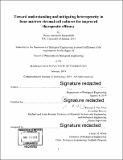| dc.contributor.advisor | Krystyn J. Van Vliet. | en_US |
| dc.contributor.author | Rennerfeldt, Deena Antoinette. | en_US |
| dc.contributor.other | Massachusetts Institute of Technology. Department of Biological Engineering. | en_US |
| dc.date.accessioned | 2019-07-22T19:32:13Z | |
| dc.date.available | 2019-07-22T19:32:13Z | |
| dc.date.copyright | 2019 | en_US |
| dc.date.issued | 2019 | en_US |
| dc.identifier.uri | https://hdl.handle.net/1721.1/121873 | |
| dc.description | Thesis: Ph. D., Massachusetts Institute of Technology, Department of Biological Engineering, 2019 | en_US |
| dc.description | Cataloged from PDF version of thesis. | en_US |
| dc.description | Includes bibliographical references. | en_US |
| dc.description.abstract | Bone marrow stromal cells (BMSCs), a subset of which are considered mesenchymal stem cells (MSCs), have been used in over 600 clinical trials for indications ranging anywhere from autism to liver cirrhosis to diabetes. They have cited enthusiasm in the cell therapy community not only for their demonstrated differentiation potential toward several lineages, but also due to the anti-inflammatory and immunomodulatory effects of their secretome. However, the necessary in vitro expansion of BMSCs renders cell populations functionally diverse, and understanding of what drives heterogeneity onset - as well as which distinct phenotypes elicit therapeutic responses of interest - remains an open challenge. This lack of characterization confounds studies focused on basic cell behavior as well as translational applications, and U.S. Food & Drug Administration approval for BMSC therapies has yet to be achieved for any of the several dozen indications explored to date. | en_US |
| dc.description.abstract | This thesis describes our work toward understanding the extent, mechanisms, and possible mitigation strategies regarding heterogeneity in BMSC cultures, by exploring the biophysical and transcriptomic profiles of single cells. We report our findings that cell generation most succinctly dictates the combined biophysical properties studied and that at the transcriptome level four distinct functional phenotypes exist. We further explore mechanisms by which heterogeneity emerges, demonstrating that cellular senescence and asynchronous proliferation kinetics leads to a distribution of biophysical properties and that at fixed time points cells are somewhere along a gene expression cascade trajectory from one functional state to another. | en_US |
| dc.description.abstract | We also report our discovery of novel surface marker candidates for enrichment of specific phenotypes and demonstrate that these discrete subpopulations differentially express genes implicated in the distinct, yet established therapeutic applications of immunosuppression, neurogeneration, and wound healing. These findings were enabled by our technological advancements that include complex time lapse imaging protocols, innovative assays for probing of label-free cell behavior, establishment of best practices for generating single BMSC transcriptome libraries, and robust analytical pipelines for time lapse imaging and single-cell RNA sequencing datasets. Collectively, these tools and analyses provide a strong foundation toward leveraging the discrete functional roles of this diverse collection of cells for both well-designed basic research studies and improved therapeutic efficacy. | en_US |
| dc.description.statementofresponsibility | by Deena Antoinette Rennerfeldt. | en_US |
| dc.format.extent | 627 pages | en_US |
| dc.language.iso | eng | en_US |
| dc.publisher | Massachusetts Institute of Technology | en_US |
| dc.rights | MIT theses are protected by copyright. They may be viewed, downloaded, or printed from this source but further reproduction or distribution in any format is prohibited without written permission. | en_US |
| dc.rights.uri | http://dspace.mit.edu/handle/1721.1/7582 | en_US |
| dc.subject | Biological Engineering. | en_US |
| dc.title | Toward understanding and mitigating heterogeneity in bone marrow stromal cell cultures for improved therapeutic efficacy | en_US |
| dc.type | Thesis | en_US |
| dc.description.degree | Ph. D. | en_US |
| dc.contributor.department | Massachusetts Institute of Technology. Department of Biological Engineering | en_US |
| dc.identifier.oclc | 1102635527 | en_US |
| dc.description.collection | Ph.D. Massachusetts Institute of Technology, Department of Biological Engineering | en_US |
| dspace.imported | 2019-07-22T19:32:11Z | en_US |
| mit.thesis.degree | Doctoral | en_US |
| mit.thesis.department | BioEng | en_US |
